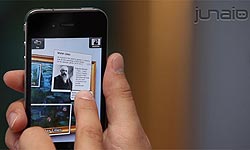 Augmented reality appears to be the successor to QR codes for the mobile buzz crown in 2012. AR is another acronym that has been long in coming, and with a legacy of
decidedly mixed results. Early users of the Layer app and Junaio may have found that having an overlay of localized search results on your phone cam’s view of the world often is cooler than it
is useful. And perhaps even more so than with those fugly checkerboard mobile codes, there is a considerable consumer education curve. According to a Ypulse survey and interviews with over 1300
high school and college- age “millennials,” only 11% of the most adventurous mobilistas have ever used an AR app.
Augmented reality appears to be the successor to QR codes for the mobile buzz crown in 2012. AR is another acronym that has been long in coming, and with a legacy of
decidedly mixed results. Early users of the Layer app and Junaio may have found that having an overlay of localized search results on your phone cam’s view of the world often is cooler than it
is useful. And perhaps even more so than with those fugly checkerboard mobile codes, there is a considerable consumer education curve. According to a Ypulse survey and interviews with over 1300
high school and college- age “millennials,” only 11% of the most adventurous mobilistas have ever used an AR app.
Granted, there hasn’t been a sensible pathway to adoption.
Some specific promotions have involved magazines and entertainment properties letting you superimpose some celeb or model onto a real-life scene via your phone cam. AR is just a bit harder than QR
to slip into the consumer’s path. There is no standard like QR that allows for easy interoperability in third-party apps. Most programs that a consumer would happen upon require some
explanation from whatever physical object is prompting the activity. A download is required. In other words, generally it is still a long walk for all but the tech- curious.
advertisement
advertisement
And the payoffs
generally are still rudimentary. That may be why even those among the youngsters who have tried an AR app are not especially enthusiastic. Only 36% of the 11% who tried AR said they thought it was
“easy and useful,” but 26% felt it was “easy but not useful.” Another 18% said it was useful but not easy, and 9% didn’t give AR any slack -- saying these apps are both
difficult and useless.
Even the more widespread campaigns like Starbucks' AR-enabled holiday coffee cups produced only mildly entertaining results. AR search engines generally require that
you have to apply specific layers of data onto the scene and then twirl in place to see all of the nearby resources pop up into your range of view. The thing is, scanning a QR code in a public place
can be awkward enough. Standing in place in the middle of a street while you pan a smartphone 360 degrees and try to find the results in a sun-challenged LCD is not exactly the search experience I
have in mind.
According to Ypulse, the 60% of Millennials who say these apps are actually easy to use beat out the 51% who say the same thing about QR codes. Ypulse speculates
that the disparity has to do with the much more widespread, but uneven, deployment of QR codes everywhere without sufficient explanation. Well -- that and the fact that people who would play with AR
likely represent a more tech-curious slice than the broader base for QR scanners.
Whatever. The promise of a standardized, user-friendly AR component to mobile is, like QR, too delicious to
overlook. Using the device to connect the physical environment with a highly contextualized digital well of data is the essence of making the world truly clickable. I think consumers would love to
see their shelf goods come to life with pop-up graphs of nutritional information, or even an animation of what else a food product or piece of apparel goes with.
Combining the ubiquity of QR
with the functionality of AR could be very satisfying. Rather than having a scannable code kick you over to a mobile site or app download, why not have it simply pull into the viewing screen
relevant information, or an entertaining mobile experience? AR needs to get beyond its own coolness.